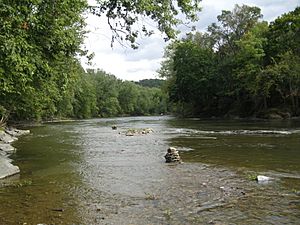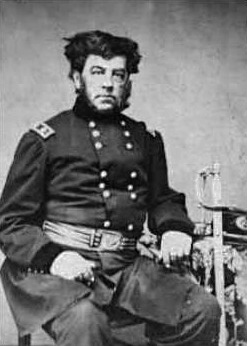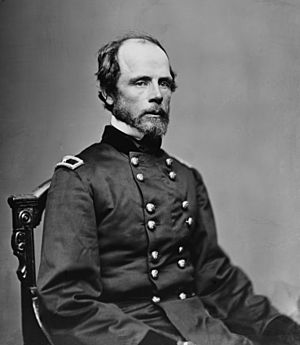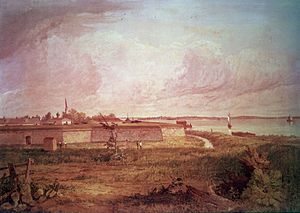Fishing Creek Confederacy facts for kids
Quick facts for kids Fishing Creek Confederacy |
|||||
|---|---|---|---|---|---|
 The Fishing Creek Confederacy took place in the vicinity of Fishing Creek |
|||||
|
|||||
|
Pennsylvania Historical Marker
|
|||||
| Designated: | July 26, 2009 | ||||
The Fishing Creek Confederacy was a rumored military uprising in parts of Columbia County, Pennsylvania and Sullivan County, Pennsylvania during the American Civil War. Many people in Columbia County did not like the military draft, which was a way to force people to join the army. This led to many people running away from the army (called desertion) or finding ways to avoid joining (called draft evasion).
For example, in July 1863, 618 people were chosen for the draft in Columbia County. About 75% of them, or three out of four, found ways to avoid joining. By the summer of 1864, rumors started spreading. People said that those who avoided the draft, along with others who supported the Southern states (the Confederates), had built a fort with cannons on North Mountain. This mountain was near Fishing Creek. The rumors claimed 500 people were guarding this fort. When the government heard these stories, 1,000 soldiers gathered near Bloomsburg in Columbia County.
On August 21, 1864, the soldiers began marching up Fishing Creek. For a week, they searched the northern part of Columbia County for people who had run away from the army or avoided the draft. They didn't find any fort or large group of rebels. However, on August 28, they arrested 100 local citizens. Most were later released, but some were taken to Fort Mifflin, a prison near Philadelphia. The soldiers kept searching, but found no proof of a conspiracy. They returned to Bloomsburg and stayed in the county until December 1864. The last prisoners from Fort Mifflin were released several months later.
The story of the Fishing Creek Confederacy was widely covered in newspapers at the time. Later, historians and researchers also studied this unusual event.
Why People Were Upset
In the early 1860s, many people in Pennsylvania supported the Democratic Party. The president at the time, Abraham Lincoln, was a Republican. When a large number of men from Columbia County were chosen for the army draft, it caused a lot of tension.
In 1862, local newspapers were angry about 636 men being drafted. Most of these men were mechanics and laborers. A new law in 1863 made things worse. It said that all men between 20 and 45 years old had to be drafted. On July 20, locals broke into the draft office and stole items. But generally, there wasn't much violence against draft officials in 1863.
People held meetings to protest the draft law. They said they would not support a war that went against the Constitution. The Columbia Democrat newspaper also spoke out against the new draft laws. Tensions grew even more after a difficult military campaign in Virginia in early 1864. By June of that year, 75% of all people drafted in Columbia County did not show up. This showed how much people opposed the draft.
The community of Mifflinville had especially high tensions. People there accused each other of being part of a conspiracy. These accusations became exaggerated, leading to the rumors of a fort in the mountains near Fishing Creek. Some people even claimed they had seen the fort and the trails where cannons were supposedly dragged.
In July or August 1864, a Union soldier named Robinson was shot near Raven Creek. This shooting was first blamed on a political group, but it was later found that the group had already broken up.
Searching for Deserters
In late July 1864, Lieutenant James Stewart Robinson and Solomon Taylor, along with six other Republicans, decided to search for Democratic deserters. This group, mostly Civil War veterans, was called the "Lincoln Midnight Riders" by a local newspaper. They planned to search Union County, but ended up in Columbia County instead.
On July 30, 1864, the group started their search. They looked for several deserters but couldn't find them. Finally, they tried to find a man named Thomas Smith in Benton Township. While they were there, four more people joined the Lincoln Midnight Riders. Thomas Smith ran into a cornfield, and his wife warned the neighbors. A group of locals arrived, including at least three armed deserters.
Solomon Taylor told the local group not to shoot. It's not clear who fired first, but three shots were heard. One shot hit Lieutenant Robinson. The deserters ran away, and the Lincoln Midnight Riders chased them for a short distance before turning back. The shooting was reported in the Columbia Democrat newspaper. Robinson later died from an infection on November 3, 1864.
The Search for the Fort
On August 4, 1864, rumors of a conspiracy in Columbia County reached Harrisburg and Washington, D.C.. A Captain Manville asked for soldiers to be sent to arrest deserters. Forty-eight soldiers arrived on August 13 at the Bloomsburg Fairgrounds in Bloomsburg. They brought two cannons and artillery equipment. Two days later, 250 more soldiers arrived. Important local residents, including U.S. Senator Charles R. Buckalew, told the soldiers there was no armed force in the county.
On August 16, Major General Darius Couch arrived to lead the troops, and more soldiers came that day. Colonel John Gosse Freeze sent a message to northern Columbia County. It said that any draft evaders who reported to Bloomsburg by August 20 would be forgiven. By August 21, there were 1,000 soldiers in Columbia County. They began marching up Fishing Creek to search for the rumored fort. That evening, they camped near Benton, Pennsylvania.
While soldiers were still arriving, the people of Benton held a meeting on August 14. They discussed whether to fight the soldiers. Many argued against it, but about 75 men said they were ready to resist. These men were led by Jacob Schultz, Samuel Kline, and one person from Orangeville. When the draft evaders learned the army was too strong, about 20 of them escaped to North Mountain.
For the next week, army scouts searched the northern townships of Columbia County. They found no evidence of a military uprising. They did raid chicken coops and pigpens they found. At this point, Major General George Cadwalader arrived to take command.
On August 28, 1864, soldiers surrounded 100 houses in northern Columbia County and parts of western Luzerne County. One hundred Democrats, sometimes called "Copperheads" (a term for Northern Democrats who opposed the Civil War), were arrested. They were marched to a church in Benton. Forty-five of these prisoners were accused of disloyalty and taken to Fort Mifflin near Philadelphia. Most of these prisoners were 40 years old or older. Only seven were found guilty, and six of those were soon pardoned. Most people were released within eight months.
The morning after the arrests, the soldiers continued marching north. They went 10 miles (16 kilometers) further to the headwaters of Fishing Creek and the base of the mountains. From there, they marched up the valley of East Branch Fishing Creek to its source. The soldiers searched the mountains for half a day, going as far north as southern Sullivan County. They climbed to the top of North Mountain in three groups. They found some signs that people had been in the area, but these seemed to be hunting or logging camps.
Eventually, the soldiers found no evidence of a fort. They went back down Fishing Creek to Bloomsburg. Still not satisfied, the soldiers searched several homes in northern Columbia County. They captured some residents on August 31, but these people were soon released.
What Happened Next
After returning from the mountains, the soldiers camped and then went back to Bloomsburg on September 6. That day, George Cadwalader said about the rumored uprising: "The whole thing is a grand farce" (meaning a big joke). Even after the search for the fort was given up, the people held in Fort Mifflin were not released right away.
The soldiers stayed in Columbia County for several months, still looking for deserters. As late as November 2, a newspaper reported that deserters were still being arrested. On November 16, about 30 soldiers went to Dushore to arrest more deserters. The soldiers were still in Columbia County on Election Day in 1864. They guarded the voting places during the local and state elections. Between four and sixty armed soldiers were at each polling place. Some local newspaper editors said the soldiers were there to stop Democrats from voting. They arrested 44 Democrats and took them to Fort Mifflin. In four townships, voter turnout was much lower than the previous year.
By December 1, 1864, all soldiers had left Columbia County. They went to Clearfield County to continue searching for deserters. While there was clear evidence of many people avoiding the draft in Columbia County, there was never a serious armed resistance. After the soldiers left, the Democrats in the county were very upset by the arrests.
It's likely that the rumor of the fort came from people seeing large piles of wooden shingles. These were gathered by shingle makers who were avoiding the draft. Also, wooden tubs used for collecting sap from sugar maple trees might have looked like cannons from a distance. A small cabin on North Mountain, used as a hideout by deserters, might have been exaggerated by Republicans into claims of a fort. A structure that might have been this cabin was found again on July 13, 2007.
The trials for the Columbia County residents held at Fort Mifflin happened in October and November 1864. At least three people admitted to being at a secret meeting on August 14. They said many people were armed at the meeting and intended to resist the soldiers. However, most prisoners were released by January 1865, though a few were held until May 1865. No one was charged for the shooting of Lieutenant Robinson until 1891. Elias Young was arrested and charged then. Young said he fired a gun, but also that two people in the searching party fired first. The court decided Young was acting in self-defense, and he was found not guilty.




